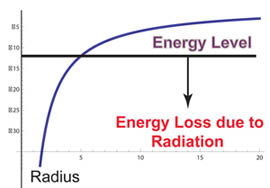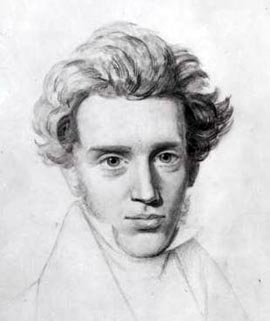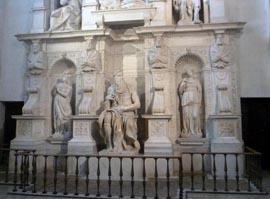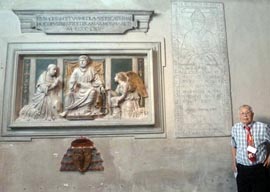100 Years after Bohr's Hydrogen Atom (1913). Entanglement?
-
By 1900, physicists found out the energy levels of the hydrogen atom,
and Rydberg was able to write down his formula in 1908.
Bohr and Copenhagen School
- One hundred years ago, in 1913, Niels Bohr presented his picture of the
hydrogen atom, and present his rule of quantized electron orbits. This
aspect is well known.
Bohr then developed the concept of complementarity which constitute the backbone of the Copenhagen interpretation of quantum mechanics, namely the wave-particle duality. This aspect is also well known.
Yet, there remains one intriguing question. How did Bohr get the idea of complementarity? We all know that Einstein was heavily influenced by Immanuel Kant. Who was the philosopher behind Bohr? It is an accepted view that Bohr's philosopher was Soren Kierkegaard. You are invited to the following webpages.
Kierkegaard is known as one of the early pioneers of Existentialism addressed to us by Jean Paul Sartre.The question then is from where Kierkegaard (1813-1855) get his idea? From Kant (1724-1804)? May be, but there seems to be another important ideological pool which affected many philosophers including Kierkegaard.
- In theology, God is Kant's Ding-an-Sich. Since not many people met
God personally, different people have different interpretations of God
depending on their backgrounds. Egyptians started this debate and came
up with the concept of one God. In Christianity, this debate has been a
continuing process since
the Nicene Creed (325 AD), and became accelerated during the
Renaissance period where the God-centered world was transforming itself into
an individual-centered world.
On the other hand, the church's role has been and still is to adopt one interpretation and forbid all others. Thus, if there were debates about God among theologians, they were thoroughly hidden by the church.
|
Bohr and Einstein

|
-
Not everybody was happy with the Copenhagen interpretation of
quantum mechanics. Einstein was not happy. This has been and
still is one of the most outstanding problems of physics. In
the past, I have constructed a number of webpages on this issue.
You may visit the following pages.
- Heisenberg talks about Einstein.
-
Bohr and Einstein.
- Einstein needs quantum mechanics.
- Evolution of the Hydrogen Atom
- Why was Einstein so against
quantum mechanics? I do not think Einstein was against his photo-electric
effect. I think he had a great respect for Bohr. I think Einstein was
frustrated because Bohr's hydrogen atom did not accommodate Einstein's
relativity. Bohr sensed Einstein's frustration and he added "time"
whenever he mentioned "space," even though he could not accommodate
Einstein's relativity in his mathematical formulas. I am not the first
one to think in this way.

- Paul A. M. Dirac was not
completely happy with the Copenhagen interpretation. However,
re-examinations of the present form of quantum mechanics can come
only after we examine whether the wave-particle duality is
consistent with relativity. As you know, I believe in Dirac.
Then what are the Einstein issues for the hydrogen atom?
- The electron orbit is now replaced by a standing wave.
- How would this standing wave appear to a moving observer?
- Are there hydrogen atoms moving with relativistic speed?
The answer to this question is No. The hydrogen atom
is a neutral object and cannot be accelerated, even with
the present technology.

- These days, the proton is a bound state of three quarks, and
consists of two standing waves. The proton speed can reach
0.999999..(I do not know how many 9s), and it is criminal not
to study Lorentz-boosted standing waves. I am not the first
one to study the standing waves in the Lorentz-covariant world.
We know how to deal with standing waves in the Galilean world. We have to impose boundary conditions. What happens to this boundary conditions in Einstein's Lorentz-covariant world? Have you heard anyone mentioning this problem?
- We do not have to worry about this problem if we use harmonic
oscillators with built-in boundary conditions, as noted by Dirac,
Yukawa, Feynman, among others.

- We can construct at least one Lorentz-covariant standing wave if
we synthesize the following three papers written by Dirac.
- P. A. M. Dirac, Proc. Roy. Soc. (London) A114, 243 (1927) --
on time-energy uncertainty relations.
- P. A. M. Dirac, Proc. Roy. Soc. (London) A183 , 284 (1945) --
on using harmonic oscillator wave functions in the Lorentz covariant world.
- P. A. M. Dirac, Rev. Mod. Phys. 21 , 392 (1949) -- on the light-cone coordinate system.
If we synthesize these three papers, we end up with the result which can be summarized by this cartoon. It has been a pleasure for me to be able to translate Dirac's poems into cartoons. Click here to see the assembly process.
- P. A. M. Dirac, Proc. Roy. Soc. (London) A114, 243 (1927) --
on time-energy uncertainty relations.

- The electron orbit is now replaced by a standing wave.
- This table summarized how physical
theories were developed in the past. It is easier to understand the
history of physics if we divide the world into scattering and bound-state
problems. In the quantum world, scattering problems are about running
waves where all the particles become free particles asymptotically. Feynman
diagrams seem to satisfy this need.
For bound-state problems there seems to be one set of wave functions, namely those of harmonic oscillators. Thus, the scattering and bound-state problems take two different mathematical forms. However, the more fundamental question is whether they share the same set of principles in quantum mechanics and relativity. The answer to this question is Yes. Click here for a published paper on this subject.
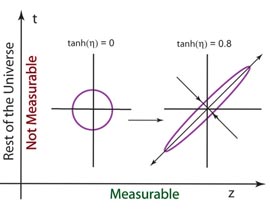
-
Squeeze and Entanglement.
We all know that Lorentz transformations
are not rotations. However, the variable separability is maintained in the
light-cone coordinate system. The proton wave function retains its
separability, but what happens in the space-time coordinate system. It is
a squeeze transformation. As a consequence, the wave function becomes
entangled.
- Click here for an one-page explanation
in terms in terms of figure and formulas.
- Click here for a published review paper on this subject.
- Click here for an one-page explanation
in terms in terms of figure and formulas.
- There are many people who question the foundations of quantum mechanics. It may help them if they realize the present form of quantum mechanics started from Bohr's hydrogen atom. Go back to his hydrogen atom and find out what went wrong there.
|
The photo of Bohr and Heisenberg is from the public domain. The photo of Dirac and Heisenberg is from the AIP Emilio Segre Visual Archives.
